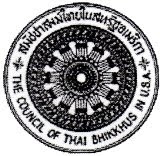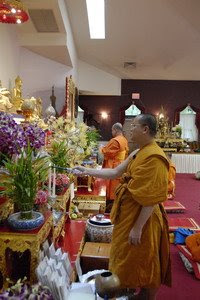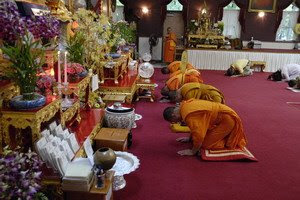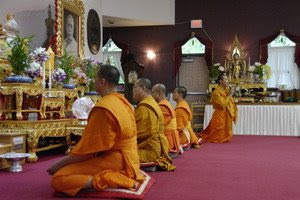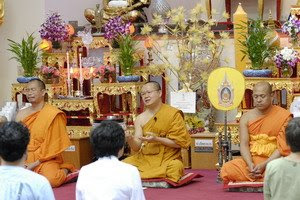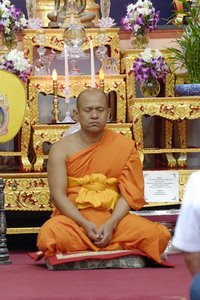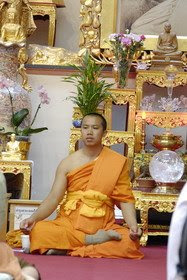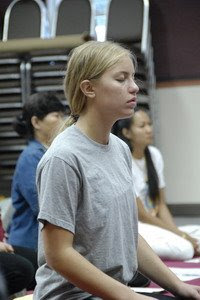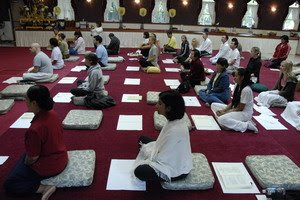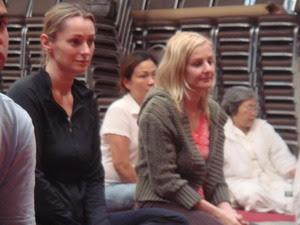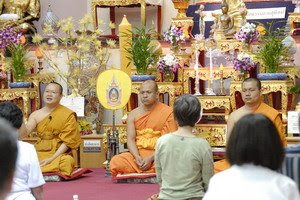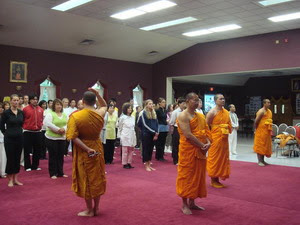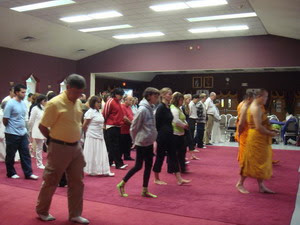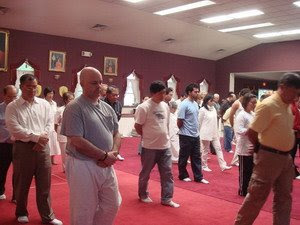กรรมฐาน จากหลวงพ่อจรัล จ.สิงห์บุรี
กรรมฐานจากพระอาจารย์ทองมั่น
The Council of the Thai Bhikkhus in U.S.A.
The Council of the Thai Bhikkhus in U.S.A.
The Council of the Thai Bhikkhus in the U.S.A. is the non-profit religious organization.
Blog Archive
Sunday, September 28, 2008
Meditation Workshop at Wat Mongkolthepmunee,PA.
Introduction to basic meditation by Ven.Dr.Thanat

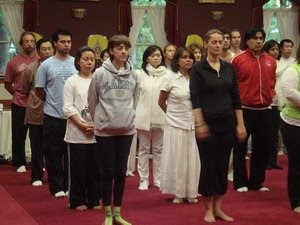

Today I would like to introduce a meditation technique for reducing stress and enhancing relaxation. The term “meditation” is used in Buddhism for “mind training” rather than the Western sense of “reflection.” It does not require developing an extremely deep stillness, just relaxation and peace. It does, however, involve studying everything that occurs internally during the meditation practice. Together, the book and the audiocassette explain the technique and provide the tools for putting it into practice.
Modern life is filled with stress. More and more individuals, suffering under social pressures, are turning to meditation as an effective remedy with the ability to relieve stress while also elevating both external functioning and internal peace.
This technique does not require any special religious beliefs or practices. It is founded on scientific principle that work for all, and has been successful tested by a cross-section of international meditators from various cultural and religious backgrounds. It can work for you.
The six steps for stress reduction and relaxation
1. The Sitting Position
Some people prefer to sit on a hard, straight chair, but most sit on cushions on the floor. You can stack up two or three cushions, if that is more comfortable. Sit on the front one-third of the top cushion, so that it helps to keep you from falling backwards.
Make yourself comfortable in any position you like. Usually we use the Lotus Position. Cross your legs – your right leg over the left. Sit upright. That is more important than anything else. Keep your spine straight and vertical. Relax. You may cross your hands and place them in your lap, or hold your knees – whichever is more comfortable. Relax your entire body, just keeping the spine straight. Check your sitting position to make it most comfortable. Lean sideways – to the right and left, then front and back. Finally, return to the center, perfectly upright and balanced.
All of this should be relaxed. Don’t be stiff. Relax, but sit upright. Keep your back straight. Hold your head up, with your chin so that your eyesight is parallel with the floor. Relax. Then, close your eyes and your mouth softly. Check again that you are comfortable and can sit in this position for a long time. This is the sitting position.
2. Relaxing
Visualize that you are the boss. The mind is the maker – the mind is the doer. Set your mind to checking your muscles from your feet up to your head – up and down, back and forth. Makes sure that all of your muscles are relaxed.
Start from your feet, then to your ankles, your legs, your knees, and your things. Then, check from the navel down – this is the lower part of the body. Every muscle should be relaxed.
Now, check from the navel up to the shoulders – this is the central part of the body. Check that the abdomen, chest and shoulders are relaxed. Check the shoulders again – relax further. Check your arms and your hands. Relax all your arm muscles. Relax your hands and your fingers.
Now check your neck and your head – this is the upper part of the body. Lower, raise, and twist your head to stretch the neck. Then, relax the neck muscles. Next, visualize starting from your scalp, your forehead, your eyebrows, your eyelids, your cheeks, your ears, your upper lip, lower lip, and, finally, your chin. Make all of this relaxed.
Check up and down, back and forth from foot to head a couple of times. Visualize checking the relaxation of your muscles. Let your mind work for you. You are what you think you are. Think big – think relaxing.
3. Mental Detoxification
Next, we come to mental detoxification – cleansing the mind and body. You shower to clean your body on the outside. Mental detoxification is the technique for internal cleansing. When your sensory organs come into contact with external stimuli, you use some of the energy coming in, but the left over forces turn into toxins. Toxins enter the body through all six of the sensory organs – the eyes, the ears, the nose, the tongue, the skin, and the mind. You must get rid of these toxins everyday to purify your mental and physical facilities and keep them functioning well.
Toxins are the cause of stress – the cause of sickness – the cause of laziness. When you eliminate all of the toxins, you will feel fresh and enthusiastic – ready for action. You will be alert in mind and body.
We get rid of toxins through mental detoxification. As you take a deep breath, visualize that good, clean oxygen comes inside. This is the chemical for cleansing your mind and body. Inhale and hold your breath briefly, to let the oxygen spread throughout every cell in all parts of your body. Then, exhale, while silently reciting to yourself “release.” Visualize that the oxygen cleans up all of the toxins that contaminate your body.
Inhale good oxygen. Hold your breath a little bit, and exhale, with a sense of release. This is the technique for mental detoxification. Relax. Recite for yourself “release” every time you exhale. Sense that you are releasing the toxins. Be your own boss. Use your mind to clean up the body. Also, cleanse any toxins that are clouding your mind. Every time you exhale, recite silently “release,” and feel your mind working for you to clean up your whole system.
When your mind becomes blurred, it is because of unwholesome thoughts – thoughts concerned with desire/greed, or anger/hatred, or confusion/delusion. While you are engaged in detoxification, try to eliminate greed, hatred, and delusion, as much as possible.
Visualization is what makes mental detoxification effective. Your mind must be very strong. Be mindful and use your mind power to clean inside your body and mind. You are what you think you are. Think big. Think success. Think accomplishment. Then, your mind will work for you. Relax. Clean up both your mind and your body. A sound mind and sound body must work together for good, coordinated, functioning.
When you are finished with mental detoxification, go back to checking again. Feel the relaxation of the muscles from your feet up to your head one more time. Repeat checking up and down. Now, you may adjust your sitting position – not too tight, not bending forward or backwards. Arrange yourself into a good, comfortable position in which you can remain for a long time. Now, get back to knowing you body. Visualize that your feet are relaxing – then, your ankles, your knees, your legs, your thighs, the lower part of the body, the central part of the body, and the upper part. All of these muscles are relaxing. Repeat your checking up and down.
The mind is the master – the mind is the doer = you are what you think you are. The mind can work for you. Be mindful, following and knowing the actions of the mind.
4. Knowing Your Breathing
Next, learn to know your breathing system. First, know it while breathing is normal – inhale and exhale normally, knowing your breathing. Next, dramatize it in order to see your breathing clearly. Take a deep breath and hold it a little bit – follow the breath from your nose all the down to your abdomen. Then, exhale. Now, take a medium breath – just from the nose down to the chest. Then, exhale. Finally, take just a short breath. Force the breath quickly in and out just at the nose. Thus, we have learned to know three rhythms of breathing – deep, medium and shallow.
Breathing can also be coarse and rough, like snoring, or very fine and smooth. Try experimenting. Take deep, medium and short breaths. Then, make your breathing rough and coarse, or very fine and smooth.
Emotions are attached to breathing. When you are in a bad mood or get heated up and almost lose your temper, you take very short, rough breaths. When you take short breaths, you get less oxygen and feel tired. This heats up your temper. That kind of breathing makes you very emotional.
Knowing your breathing is useful for controlling your emotions. Work with breathing rhythms. They become the tools for controlling your emotions. You may have heard one person telling another “calm down, calm down – take a deep breath.” This is, in fact, the technique. To calm down, take deep breaths that are very fine. You will soon get back to normal. The more you keep cool and calm, the more peace and happiness you will attain. When you become hot-tempered and blow your top, you create more stress and feel even worse.
This completes the major components of knowing – knowing your sitting position, knowing your body and relaxing your muscles, mental detoxification, and knowing your breathing rhythms. We shall now discuss two related topics emphasized in Eastern philosophies – knowing the great elements and knowing impermanence.
5. Knowing the Great Elements
Continuing in more detail, according to Eastern philosophies, knowing yourself involves knowing the great elements. The four great elements are earth, water, fire, and wind – solids (organs, etc.), liquids (blood, etc.), warmth, and breath, these combine to form life, or yourself.
In India, philosophers add two more great elements – space and consciousness. Space is similar to cyberspace in information technology. It is the medium in which our body exists. There is also space inside our body. The wind is mixed with the blood and flesh and bones, but the space is between our organs. Consciousness comes with mindfulness. When we become mindful, consciousness is the result of our knowing.
To know yourself thoroughly, think of the four or six great elements. Know how they work together. Then, when we come to talk about suffering, impermanence and non-self, you will realize that all of this is interrelated. When you are in a good mood and are enthusiastic to do something, it means that you have good functioning between body and mind, and proper proportion among the elements.
6. Knowing Impermanence
From observing your breath and your thoughts, know that everything is impermanent – constantly changing. Nothing remains the same from moment to moment. Know, also, that you cannot control this change. You cannot hold your breath very long, or keep your mind from thinking. This is the meaning of saying that everything is non-self (not you or yours) – you cannot control it.
Because we see ourselves as enduring entities, and are usually trying to hold onto something or some state we have achieved, we usually experience this constant change as stress, discomfort, or suffering. This is the delusion we referred to earlier.
On the other hand, know that the pain you may be feeling in your legs is also impermanent. Just know it and wait for it to pass away. This provides a model for dealing with problems in daily life. Know that they are impermanent. Don’t worry, time will take its course. Just take a rest, relax, and forget about it for a little while. You might meditate to clear up your mind. Then, the problem will become easy to solve. It may come to you “Ah, that’s the way to tackle this problem.” This is another technique for preventing stress.
CLICK HERE TO SEE LIVE VIDEO
CLICK HERE TO SEE LIVE VIDEO
Posts (Atom)
กรรมฐาน งานของใจ อยากให้รู้
เพราะมีอยู่ สองอย่าง ทางผ่องใส
เป็นการฝึก- ฝนดู รู้ภายใน
ให้พ้นทุก- ขภัย ใจชุ่มเย็น
อย่างที่หนึ่ง สมถ- กัมมัฏฐาน
ที่เป็นงาน ดับภัย หายทุกข์เข็ญ
มุ่งฝึกใจ ให้จดจ่อ บริเวณ
ทำให้เป็น เอกจิต พินิจดู
อย่างที่สอง วิปัสสนา กัมมัฏฐาน
ที่เป็นงาน ฝึกใจ มุ่งให้รู้
มองอารมณ์ จากสารทิศ พินิจดู
ที่มาสู่ ภายใน ให้รู้ตาม
กำหนดปล่อย คอยดู อยู่ปัจจุบัน
ที่แปรผัน ไม่เคยพัก ลักษณะสาม
ที่แปรเปลี่ยน หมุนเวียนคล้อย คอยดูตาม
มองให้เห็น ไม่งาม ตามเป็นจริง
สติดู รู้เท่าทัน ปัจจุบันเหตุ
ตัดกิเลส ด้วยปัญญา พาสุดหนิง
มีวิริยะ พากเพียร จำเนียรจริง
สมาธิ แนบนิ่ง ไม่อิงใคร
อดีตละ อนาคต จงหยุดอยู่
วางใจดู แต่ปัจจุบัน ทันสมัย
มองให้เห็น ลักษณะสาม ตามปัจจัย
กาย,เวทนา จิต,ธรรมใน ให้รู้ตาม
………………………………………………..
กัมมัฏฐาน อยากจะบอก ฟอกดวงจิต
ไม่วิปริต มีแต่ผ่อง ไม่หมองศรี
ดับทุกข์โศก โรคภัย ในโลกี
ช่วยขัดสี จิตที่หมอง ให้ลองดู
แล้วจะเห็น ความจริง ที่ยิ่งยวด
ไม่ได้อวด วาทธรรม พร่ำหรูหรู
เปรียบทะเล ที่สวยเด่น เห็นปลาปู
จิตสะอาด แจ่มใสรู้ ทุกอณูธรรม







